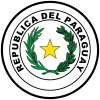Eusebio Ayala District
| Eusebio Ayala | |||
|---|---|---|---|
| District | |||
|
|||
| Coordinates: 25°22′54″S 56°57′39″W / 25.38167°S 56.96083°WCoordinates: 25°22′54″S 56°57′39″W / 25.38167°S 56.96083°W | |||
| Country | Paraguay | ||
| Department | Cordillera | ||
| Founded | 1770 by Carlos Morphi | ||
| Government | |||
| • Intendente Municipal | Nestor Fabian Delgadillo Díaz (ANR) | ||
| Area | |||
| • Total | 338 km2 (131 sq mi) | ||
| Population (2008) | |||
| • Total | 20.843 hab. | ||
| • Density | 61.6/km2 (160/sq mi) | ||
| Time zone | -4 Gmt | ||
| Postal code | 3090 | ||
| Area code(s) | (595) (514) | ||
Eusebio Ayala is a district of the Cordillera Department, Paraguay. It is named after Eusebio Ayala, a former President of Paraguay. It is located approximately 72 km of the city of Asuncion, capital of the Republic of Paraguay.
This city lies on the right bank of the stream Piribebuy, being axis road from where routes depart inside and outside the department. It is well known for being the birthplace of the famous Chipa Barrero and for being located next to the fields of Acosta Ñú, where children were slain in a battle during the Paraguayan War (1864 to 1870).
This district has a length of 338 km², with a population of approximately 20,843 inhabitants., Of which nearly 40% of the people living in urban areas, its population's density is 67.22 persons per square kilometers.
Eusebio Ayala was founded by Governor Carlos Morphi in the year 1770 under the name Barrero Grande. Previously, it was called the San Roque and Barrero Grande. Its current mayor is Mr. Nestor Fabian Delgadillo Diaz, of the NRA, for the period 2006 to 2010.
The Battle of Acosta Ñu, the final major battle in the Paraguayan War. was fought here on August 16, 1869. The Paraguayan army, composed of, by this time in the war, 6000 mostly elderly, children, adolescents, women and invalids, faced 20 000 Brazilians and Argentinians. The battle began with an infantry assault on Paraguayan positions which lasted for eight hours until the Paraguayans retreated to a fortified redoubt. The redoubt was destroyed by Brazilian artillery fire, and the defenders formed a defensive square around the eight cannon stationed there. However, the square was soon destroyed by a huge Brazilian cavalry charge, but the battered Paraguayan survivours managed to scatter them afterwards. The Brazilian commander, Gaston d'Orléans, ordered a final bayonet charge, which broke the remaining Paraguayan lines. General Caballero, the Paraguayan commander, finally ordered a withdrawal and left the field with his remaining 3000 troops. According to Brazilian historian Chiavenatto, when Eu noticed movements within the forest behind the plain of Acosta, he believed that they were Paraguayans preparing a counter-attack, and so ordered his engineers to burn the forest. The movement was in fact Paraguayan camp followers attempting to recover the injured from the field.
...
Wikipedia


